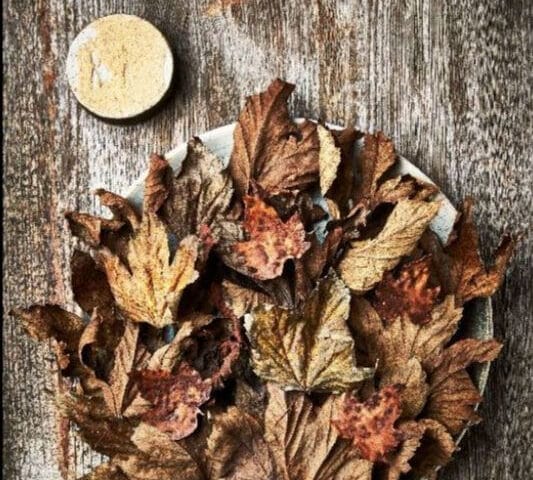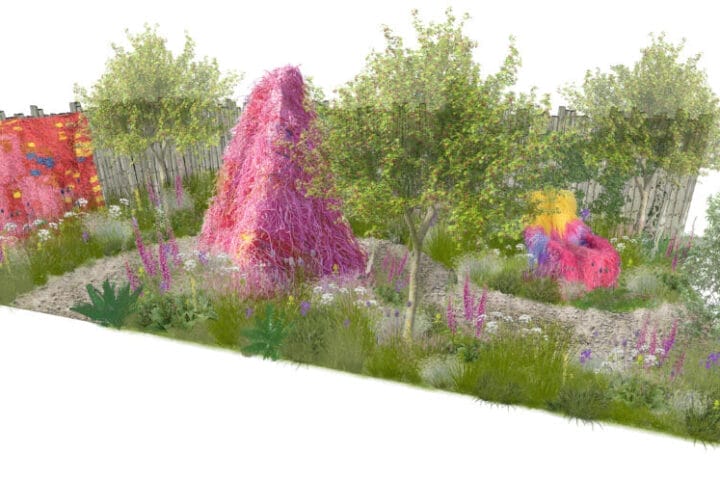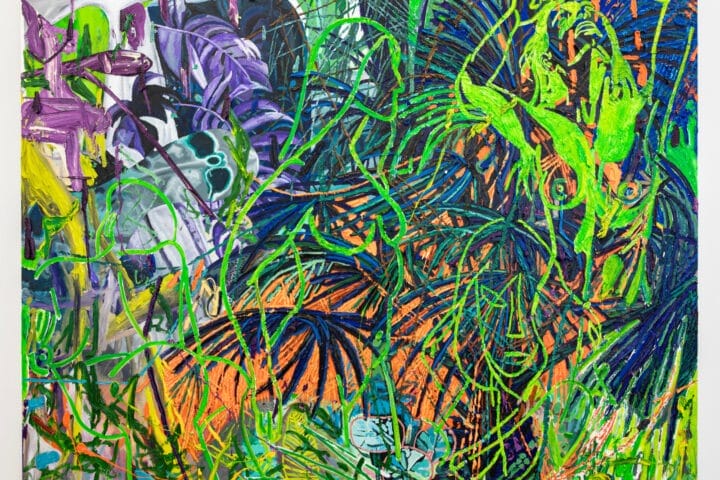David Zwirner is pleased to participate in Art Basel 2022. The booth will feature abstract paintings by Kerry James Marshall, Ad Reinhardt, Oscar Murillo, Cy Twombly, Lucas Arruda, and Yayoi Kusama alongside figurative works by Francis Alÿs, Michaël Borremans, Noah Davis, Alice Neel, Neo Rauch, Steven Shearer, Luc Tuymans, and Lisa Yuskavage.
Kerry James Marshall’s abstract painting Untitled (Blot), 2015, which will be on view, is from the artist’s Blots series, from 2014–2015, and utilizes the language of abstraction to suggest alternative ways in which Black experiences are formally manifested in painting. The first example of this body of work—which is compositionally based on the patterns of inkblots used for Rorschach tests, a popular tool in psychological evaluation in the 1950s and 1960s—was debuted in Marshall’s 2014 solo exhibition Look See at David Zwirner, London. A group of these large-scale paintings was subsequently presented in the 2015 Venice Biennale.
Also within the abstract paintings section of the gallery’s booth will be Ad Reinhardt’s Blue Painting, 1953. The painting rewards close and sustained acts of looking, acknowledges Reinhardt as not only a pioneer in the consideration of the optical and perceptual possibilities of painting but also a masterful and engaging colorist. In this work the rectangular canvas is overlaid with a centered square and two parallel, symmetrical rectilinear bands, all rendered in subtle tonal variations that are difficult to differentiate and only reveal themselves after focused observation. Blue Painting was included in Reinhardt’s exhibition of blue paintings at the Stable Gallery, New York, in 1965, which was one of three concurrent exhibitions of his black, blue, and red canvases at three galleries in New York: the black at Betty Parsons Gallery, the red at Graham Gallery, and the blue at Stable Gallery.
From the figurative focus of the booth, a painting by Luc Tuymans from 2010 titled The Riding will be on view. This painting belongs to Tuymans’s Corporate series, a far-reaching investigation into the history of the corporation, from its seventeenth-century roots through its influence on the world of contemporary art. Tuymans has a concurrent exhibition of new work on view at David Zwirner’s Paris gallery. Also within this section are two paintings by Alice Neel, one depicting her son Richard that was painted in 1967 and another of her granddaughter Elizabeth from 1984. Neel’s work will be the subject of a forthcoming solo exhibition at the Centre Pompidou in October 2022.
Another highlight of the booth will be Felix Gonzalez-Torres’s“Untitled” (Tim Hotel), 1992, which is one of twenty-two unique light string sculptures in the artist’s oeuvre. Imbued with meaning that is both personal and universal, each of these works is purposefully“Untitled”—as open and malleable as the physical form of the work. The parenthetical titles of each light string may also allude to Gonzalez-Torres’s own life and memories, while simultaneously inspiring unique recollections and associations of the individuals experiencing them. Among their many resonances, these works offer poignant meditations on the conditions of presence and absence, ephemerality and permanence. Gonzalez-Torres’s work is also the subject of an exhibition currently on view in Paris at the Bourse de Commerce.
A trio of paintings by Marlene Dumas will also be a focus of the booth: The Secret, 1994; Duct Tape, 2002–2005; and Militaristic Monomaniac, 2013. The Secret depicts a child seen from behind against a dark backdrop. Filling the entire composition, the child appears isolated and alone, but also independent, as though they are just beginning to experience the world as an individual. The painting is the subject of an online presentation as part of the gallery’s Exceptional Works series on davidzwirner.com. Dumas currently has a major monographic exhibition on view at the Palazzo Grassi in Venice.
A large-scale wave painting by Raymond Pettibon, No Title (The room is…), 2016, will also be on view and is the subject of an online Exceptional Works presentation at davidzwirner.com. A recent publication focusing on Pettibon’s surfer and wave paintings and drawings was published this month by David Zwirner Books.
David Zwirner will debut at their booth a brand new work by Huma Bhabha, who joined David Zwirner gallery in April 2022. Bhabha has created a new sculpture titled 17 that is an androgynous, multiheaded, quasi-human figure made of cork, styrofoam, acrylic, oil stick, nail polish, wood, and oil that stands on what appears to be a small patch of green grass. Posed resolutely, the figure appears to be standing guard or greeting the viewer.
At Art Basel Unlimited, David Zwirner will be presenting works by five gallery artists: Stan Douglas, Juan Muñoz, Wolfgang Tillmans, Andra Ursu?a, and Jordan Wolfson (details on each presentation can be found below).
At Art Basel Parcours, Oscar Murillo’s Social Cataracts, which is made up of two installations, will be on view at the UBS Bank Kudenhalle in Basel, presented with David Zwirner, Carlos/Ishikawa, Kurimanzutto and Taka Ishii. Social Cataracts touches on community, labor, and collectivity. The first installation, Mesmerizing beauty, 2022, consists of fifty vacant white plastic chairs, attached to which are wooden batons that appear to support placards typically used in political demonstrations but that in fact are works on paper and canvas based on drawings that the artist has made during flights, traveling across continents. The second installation, Arepas y Tamales, 2022, features one hundred wearable sculptures. More information can be found here.
On June 18 at 7 PM at UBS Geschäftsstelle, Oscar Murillo will present a live reading from the 1933 novela Parque Industrial: romance proletario (Industrial Park: A Proletarian Novel), by Patrícia Galvão, who was a Brazilian modernist writer and dissident under the Vargas dictatorship. This live intervention, as part of Parcours Night 2022, complements the first presentation of Murillo’s installation Arepas y Tamales, giving the audience an opportunity to contemplate, and to be absorbed into, the wider themes touched on by Murillo’s work.
At Kunsthalle Basel, Michael Armitage, who joined David Zwirner in February of this year, has a solo exhibition titled You, Who Are Still Alive that is on view through September 4, 2022. The exhibition of new work made over the past three years is Armitage’s debut exhibition in Switzerland, and is the artist’s most comprehensive presentation of recent work to date. It includes numerous large-scale paintings, among them the largest Armitage has ever made, and a selection of delicate ink drawings that reveal his exquisite draftsmanship. On Friday, June 17, at 5 PM in the Art Basel Auditorium, Michael Armitage will discuss artistic influences and kinship with Ellen Gallagher and Manthia Diawara, with moderation by Hans Ulrich Obrist. More information can be found here.
At the Fondation Beyeler, Lucas Arruda currently has several paintings on view in Passages – Landscape, Figure and Abstraction, until August 14, 2022. The artist will be present at a launch for his new book, Deserto-Modelo, on Thursday, June 16, between 4–6 PM. Deserto-Modelo is published in relation to the artist’s exhibition at Fridericianum in Kassel, Germany, which was on view in 2019. The book includes texts by Vicenzo de Bellis, Fernanda Brenner, Marlene Burgi, Lilian Tone, Theodora Vischer, and Moritz Wesseler.
David Zwirner Artists at Art Basel Unlimited:
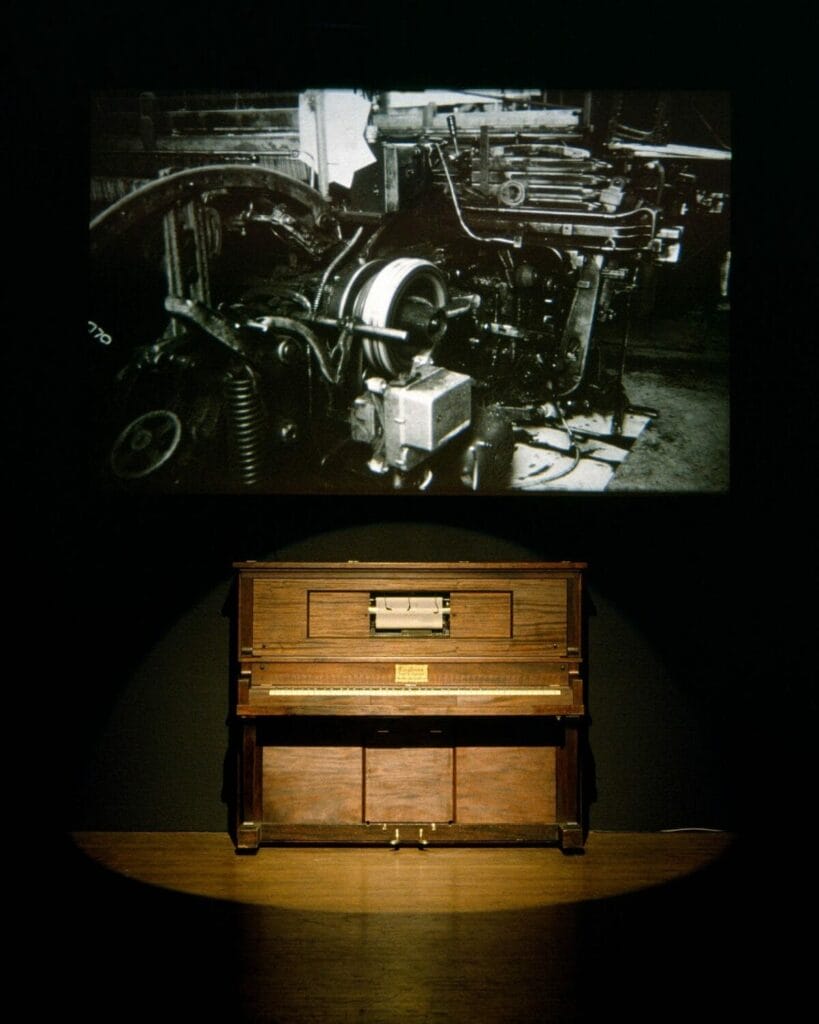
Onomatopoeia, 1985–1986
Presented by David Zwirner
Douglas’s seminal early installation Onomatopoeia consists of a fragment of Beethoven’s Piano Sonata No. 32 in C Minor (Op. 111) as rendered by a player piano in a ragtime rhythm, accompanied by looped black-and-white photographs of austere automatic looms from a nineteenth-century textile mill projected onto a screen suspended above. Both the player piano and the loom employ the same basic technology—a series of punched rolls determining both the notes played and the weave pattern of the textile.
The cinematic work, which evokes the early Industrial Age, recalls the accompaniment to silent movies by a piano. The absent interpreter, replaced by the player piano, echoes the missing weaver in the mill, establishing a human absence that is almost tangible, and the pairing of the piano and the loom keeps the audience in a state of anticipation as the structure of the piece moves in and out of synchronization.
Onomatopoeia is one of Douglas’s most important early works and helped form the foundation of his career. Although it has not been seen publicly in nearly two decades, this significant work was included in a number of important early shows, including the installation’s debut at Douglas’s 1986 solo exhibition at Western Front, Vancouver. Another edition of this work is in the collection of the Vancouver Art Gallery.

Three Chinese, 1999
Presented by David Zwirner
The present work consists of a group of three smiling figures, each looking in a different direction. The source material for these figures was an Art Nouveau ceramic bust that Muñoz found at a flea market, of a figure with Asian features who appeared to be laughing, which he then replicated numerous times, constructing various situations ranging from individual figures to large groups.
Throughout his oeuvre, Muñoz was interested in drawing from and questioning art history to make a new kind of sculptural situation that problematizes and destabilizes that history, putting viewers into a place of uncertainty, instability, or questioning. The repeated use of the same figure, as in this work, underscores a tension between individual subjectivity and the anonymity of the group—a theme that the artist consistently explored.

Concorde L449-19, 21, 22, 23, 25, 27, 28, 1997
Presented by David Zwirner and Galerie Buchholz
The present seven-part work belongs to Tillmans’s “Concorde” project (1997), which includes a grid of fifty-six related photographs and an artist book. These images, which make up the final pages of the Concorde publication, are the only large-scale prints to have been made from this series. This work was first exhibited at the Fondation Beyeler as part of Tillmans’s 2017 exhibition marking the twentieth anniversary of the project.
A significant early series within Tillmans’s oeuvre, the “Concorde” works encompass a deliberate engagement with photographic notions of cropping, framing, and serialized processes. The artist explains, “In the spring of 1997, for a few weeks, I became a planespotter. It was a fascinating thing, standing under the flypass near the perimeter fence of Heathrow, or in Richmond or Clapham, watching the very distant dot in the sky as it approached, and trying to make out: is it Concorde? Or just an ordinary plane? I had a particular problem with the McDonnell-Douglas MD80s: from afar, they look similarly back-heavy. But it was beautiful to spend hours looking up in the sky—I’ve loved the sky since childhood—waiting for it to happen, and then it would happen, and then you just had to go for it.”

Andra Ursu?a based Vandal Lust, 2011/2022 on The Man Who Flew into Space from His Apartment, (1985), a room-sized installation by the Soviet-born artist Ilya Kabakov that imagined his fantasy of escape from the communal Moscow apartment where he once resided. Ursu?a’s work comprises a trebuchet and a sculpture depicting the artist as a fallen figure—dressed in a red cardigan and headscarf—covered in the crushed debris created after an attempt to hurl herself out of the space. As noted by the artist, the work “was more about knowing you will fail but going for it anyway.” Here, Ursu?a taps into the “failure to launch” trope explored by the likes of Yves Klein and Bas Jan Ader and also questions the possibility of an individual’s ability to truly be free, particularly those living under oppressive governments in locations that have accumulated decades or centuries of collective historical trauma.
Andra Ursu?a also has work on view in the 59th International Art Exhibition at the Venice Biennale, The Milk of Dreams, curated by Cecilia Alemani.
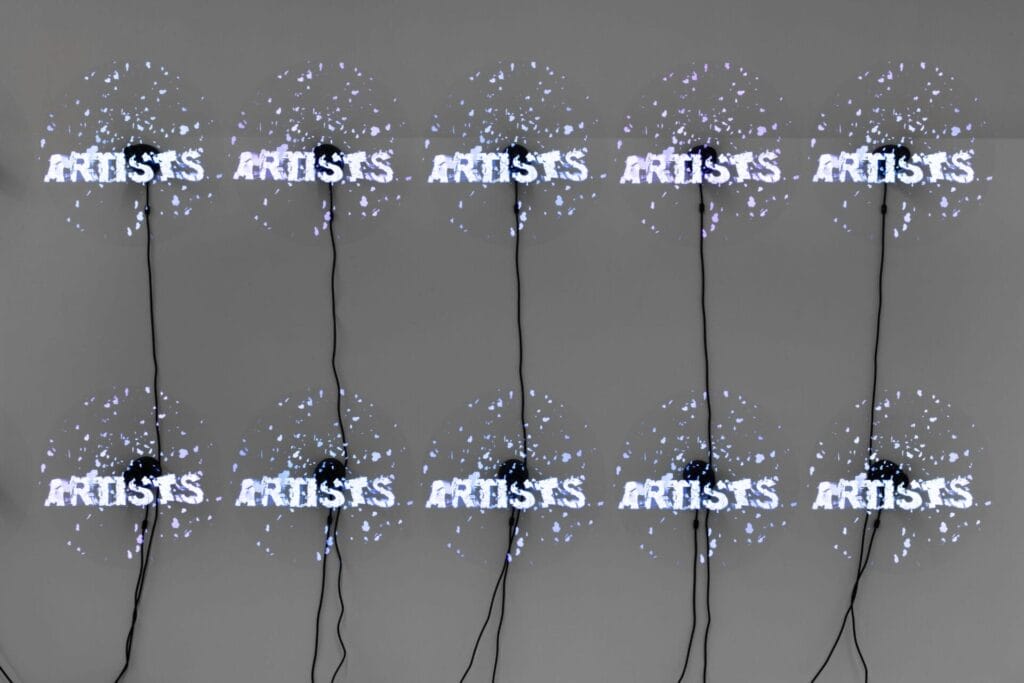
ARTISTS FRIENDS RACISTS continues Wolfson’s probing investigation of technology and mass imagery and how they relate to American culture and contemporary life. The work is composed of twenty HYPERVSN 3D holographic displays made of spinning fans that have micro LEDs embedded in their blades. The LEDs are programmed to rapidly illuminate while spinning so as to create the illusion of holographic imagery floating in space.
The programmed imagery includes animated characters and symbols such as a cartoon heart, a breakdancing Star of David, a puppy being tortured, and an imprisoned cat. Breaking up the visual display are animated words reading “ARTISTS,” “FRIENDS,” “RACISTS” that descend intermittently. At times Wolfson’s animations overlay photographs and video clips, some of which appear as relatively innocuous—like scenes from Sesame Street—while others depict charged subjects, such as police cars and 9/11 firefighters. The visual sequence plays out like a choreographed dance, with imagery at times synchronized—with multiple fans featuring the same projection—and at other times syncopated and incongruous.
At once enigmatic, comical, and disquieting, the work highlights how symbols, characters, and language have achieved a life of their own in today’s advanced image economy, existing like specters that reach beyond the confines of the media and the systems in which they circulate.
This work was presented by both Sadie Coles in London and David Zwirner at its Paris gallery in February 2020.

